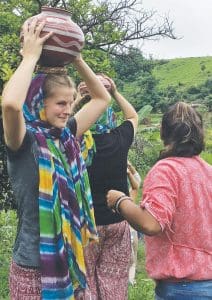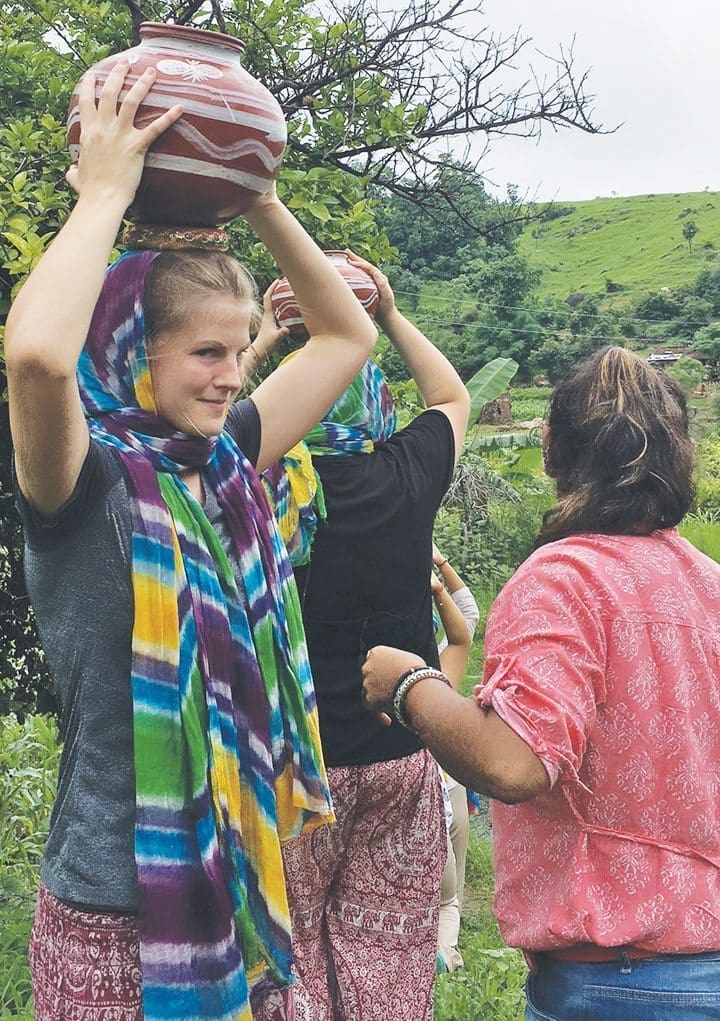Kevin McBain
of The Clarion
“We can change the world and make it a better place. It is in your hands to make a difference,” said Nelson Mandela.
Being one person in a world so big may be overwhelming, but if you try to make a difference, if you do your best, if you do one thing that affects someone in some positive way, you have made a difference. Whether it affects one person or a group of people, you have accomplished something.

Shayla starting the water walk. Some women can carry up to six of the water bowls on their head without using their hands
Kindersley’s Shayla Olafson is using her talent and skills to make that difference.
She recently returned from a Me to We group trip to India – her third Me to We working trip in the last two years. The trip encompassed 18 days: she left Calgary on July 21 and returned on Aug. 7.
She travelled from Calgary to Toronto, where they met as a group of 26 (including five advisers) before heading to India.
Shayla spent 22 hours in the air before finally landing in the city of Udaipur in the state of Rajasthan.
“Me to We followed up with me after the Dominican trip to see how things went and see if I wanted to go on another,” she said. “It was a choice between going on another trip to either China or India, or going to a Me to We facilitation camp.
[emember_protected for=”2″ custom_msg=’For more on this story, please see the Aug. 23 print edition of The Clarion.’]
“After talking it over, it was decided that another trip would be best. China was actually my first choice but that got cancelled. So it was off to India, which was good,” she added. “India is the first country that Me to We went into, where it all started, so that was kind of cool.”
She said that things didn’t start particularly well – much of the group suffered from a little jet lag and it rained heavily for the first five days – it’s monsoon season.
“The people there said that they’ve never seen anything like it,” said Olafson. “Water was running over the roads. It was crazy.”
The group stayed in the Me to We tent village, a gated community, about a half hour from their work site in Antri.
“It was pretty cool and there was enough tents to house two teams, so staying with us was a team from the U.K., which was kind of cool. We were able to interact with them while we were there,” she said.
They had their own cooks, who made some great food, according to Olafson.
“Our chef cooked some very mild Indian dishes, some Canadian food and always plain rice. There were a lot of options,” she said. “We even got to make our own samosas and eat them one day.”
Getting started …
The India experience started off with a Puja prayer opening ceremony.
The group’s project was to help build a classroom in the village of Antri.
They mostly worked at building the flooring for the room, filling in cracks around the rock floors with cement.
They were also able to break ground on a new floor for another classroom.
While working, the kids were in school.
“The kids were really cool and they even shared their secret handshake with us,” said Olafson.
A typical day …
A typical work day started with yoga, then breakfast, then getting ready and going to the work site. Once there, they got their work gear on and starting working before finally returning to the tent village for lunch. After lunch, they either returned to work – on double work days – or participated in an activity, followed by a late supper before going to bed or participating in another activity.
She said that it was busy, but they did get quite a bit of time to rest or take a shower, which she said was most welcomed by the group, especially on a trip that long.
A taste of India …
Along with working, they were able to taste several aspects of the Indian culture through several activities and tours.
They did a market activity (theoretical) at the camp, where they were given the profile of a family and had to go buy food for them.
They also took classes in painting, tie dye, block print and even Bollywood dancing.
They also toured several forts and temples, including a catfish temple where there were catfish everywhere.
The land …
Olafson said she really enjoyed taking it all in.
“It is very colourful. I really liked the views,” she said. “On our trips to and from work, I just stared out the window the entire time. It was monsoon season, so everything was really bright green.”
Education …
Olafson said the children all learn English in school and it’s one of their two main languages, along with Hindi. However, she said there are so many different languages and dialects spoken in the country.
The education is quite good. School is free for girls from kindergarten to Grade 12 and for boys from kindergarten to Grade 9.
She said that the reason is that the country is trying to empower the women more.
“They are trying to change the ideas of the people there. Me to We is trying to empower the women, to be able to sustain themselves, by providing education and resources to help them.”
Occupations …
Close to 72 per cent of the population – the country contains more than 1.2 billion people and is the most populous democracy in the world – still live in the rural areas.
“In the village, they mostly do farm work and they feed off of one another’s resources,” she said. “In the caste system, they would be the lowest.
“In the city, there are lots of little stores everywhere and that is how they make their money,” she added.
The best thing about the trip …
“The biggest thing was learning about the caste system, how it affects people there,” she said. “We also learned about social media and how it affects people and how you can use it to open people’s eyes about issues.”
She said the best part of the trip was the day they went into people’s homes and were able to get a glimpse of a typical day in their lives.
“We were able to go into the homes and see what life is like,” she said. “Most houses consist of just one room with no bathroom at all.
“For food, Me to We has supplied families with things like super seeds that they can plant. These are very hardy and produce more food,” she said. “They also have a lot of goats, and these are called super goats, who produce more offspring and more milk. This is part of the women’s empowerment aspect of Me to We.”
What’s next …
This is the third Me to We trip for Shayla, who travelled to Ecuador and the Dominican previously. Travelling and helping others is definitely in the Grade 12 student’s future.
“I might go into international studies or, possibly, to the Me to We advance facilitations next summer in Arizona,” she said. “I like to feel the impact that I’m making face-to-face, going to a country and feel the culture, being a part of it and making a connection instead of just throwing money at the project, which is okay too, but I like to go and see the people.”
[/emember_protected]
© Kindersley Clarion


